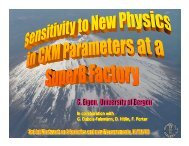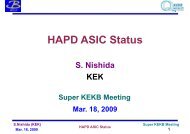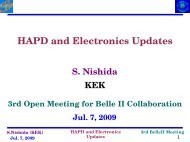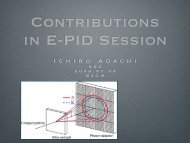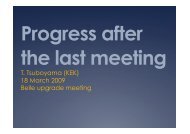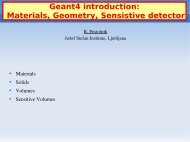DEPFET Active Pixel Sensors for SuperBelle PXD - Belle II - KEK
DEPFET Active Pixel Sensors for SuperBelle PXD - Belle II - KEK
DEPFET Active Pixel Sensors for SuperBelle PXD - Belle II - KEK
Create successful ePaper yourself
Turn your PDF publications into a flip-book with our unique Google optimized e-Paper software.
1st Open Super<strong>KEK</strong>B Collaboration Meeting, <strong>KEK</strong>, Dezember 2008 Ladislav Andricek, MPI fuer Physik, HLL 1<br />
<strong>DEPFET</strong> <strong>Active</strong> <strong>Pixel</strong> <strong>Sensors</strong><br />
<strong>for</strong> <strong>Super<strong>Belle</strong></strong> <strong>PXD</strong><br />
- Status Report-<br />
Ladislav Andricek <strong>for</strong> the <strong>DEPFET</strong> Collaboration (www.depfet.org)
1st Open Super<strong>KEK</strong>B Collaboration Meeting, <strong>KEK</strong>, Dezember 2008 Ladislav Andricek, MPI fuer Physik, HLL 2<br />
Starting Point: The <strong>DEPFET</strong> ILC VTX Project<br />
10 groups from Germany, Spain, and Czech Republic ≈40-50 people working on the project<br />
new groups <strong>for</strong> <strong>Super<strong>Belle</strong></strong>: Japan, Hawaii, Poland, Austria<br />
See <strong>DEPFET</strong> Backup Document at www.depfet.org
1st Open Super<strong>KEK</strong>B Collaboration Meeting, <strong>KEK</strong>, Dezember 2008 Ladislav Andricek, MPI fuer Physik, HLL 3<br />
<strong>DEPFET</strong> Principle<br />
DEpleted P-channel FET<br />
J. Kemmer & G. Lutz, 1987<br />
Drain<br />
Gate<br />
Source<br />
• fully depleted sensitive volume, charge collection by drift<br />
• internal amplification q-I conversion: 0.5 nA/e, scales with gate length and bias current<br />
• Charge collection in "off" state, read out on demand
1st Open Super<strong>KEK</strong>B Collaboration Meeting, <strong>KEK</strong>, Dezember 2008 Ladislav Andricek, MPI fuer Physik, HLL 4<br />
An Array of <strong>DEPFET</strong>s<br />
Row wise read-out ("rolling shutter")<br />
• select row with external gate, read current,<br />
clear <strong>DEPFET</strong>, read current again<br />
the difference is the signal<br />
• only one row active low power consumption<br />
• two different auxiliary ASICs needed<br />
gate<br />
off<br />
on<br />
off<br />
off<br />
V GATE, ON<br />
V GATE, OFF<br />
<strong>DEPFET</strong>- matrix<br />
I DRAIN<br />
n x m<br />
pixel<br />
drain<br />
0 suppression<br />
off<br />
reset<br />
off<br />
off<br />
V CLEAR, ON<br />
reset<br />
V CLEAR, OFF<br />
V CLEAR-Control<br />
output
<strong>DEPFET</strong>s <strong>for</strong> the ILC: Achievements and Status<br />
<strong>DEPFET</strong>s <strong>for</strong> the ILC VXD<br />
<br />
<br />
Prototype System with <strong>DEPFET</strong>s (450µm), CURO and Switcher<br />
many test beams @ CERN and DESY:<br />
S/N≈140 @ 450 µm goal S/N ≈ 20-40 @ 50 µm<br />
<br />
sample-clear-sample 320 ns goal 50 ns<br />
s.p. res. with 24 µm pixels: 1.3 µm @ 450 µm<br />
goal ≈ 4 µm @ 50 µm<br />
<br />
Thinning technology established, thickness can be adjusted to the<br />
needs of the experiment (~20 µm … ~100 µm),<br />
design goal 0.11 % X 0<br />
<br />
radiation tolerance tested with single pixel structures up to<br />
1 Mrad and ~10 12 n eq /cm 2<br />
In this talk:<br />
• Towards <strong>Super<strong>Belle</strong></strong>…<br />
• New irradiation of <strong>DEPFET</strong>s to higher TIDs<br />
• Consequences ...<br />
1st Open Super<strong>KEK</strong>B Collaboration Meeting, <strong>KEK</strong>, Dezember 2008 Ladislav Andricek, MPI fuer Physik, HLL 5
1st Open Super<strong>KEK</strong>B Collaboration Meeting, <strong>KEK</strong>, Dezember 2008 Ladislav Andricek, MPI fuer Physik, HLL 6<br />
The <strong>DEPFET</strong> Ladder <strong>for</strong> <strong>Super<strong>Belle</strong></strong> <strong>PXD</strong><br />
Some important numbers <strong>for</strong> the baseline layout:<br />
sensitive region : 1.15x7.25 cm 2 (L1), 1.15x9.26 cm 2 (L2)<br />
(subject to optimization)<br />
read-out time : 100kHz frame rate, 80ns <strong>for</strong> 4 rows<br />
material budget : 0.15% X0 (incl. frame, chips, bumps)<br />
power/module : <strong>DEPFET</strong>s ~ 0.5 W<br />
Switcher ~ 0.2 W<br />
DCD ~ 3 W on each ladder end
1st Open Super<strong>KEK</strong>B Collaboration Meeting, <strong>KEK</strong>, Dezember 2008 Ladislav Andricek, MPI fuer Physik, HLL 7<br />
<strong>DEPFET</strong> <strong>Pixel</strong> Cell <strong>for</strong> <strong>Super<strong>Belle</strong></strong><br />
<strong>DEPFET</strong>s from ILC to Super<strong>KEK</strong>B:<br />
-: the principle is of course the same<br />
-: technology to a large extent also<br />
-: but the cell size is much larger!!!<br />
24x24µm 2 50x75µm 2<br />
keep W and L small (maintain clear and g q<br />
)<br />
re-design drain and source region to keep<br />
Drain<br />
Gate<br />
Source<br />
charge collection time short (
1st Open Super<strong>KEK</strong>B Collaboration Meeting, <strong>KEK</strong>, Dezember 2008 Ladislav Andricek, MPI fuer Physik, HLL 8<br />
Capacitively Coupled Common Clear Gate<br />
Gate<br />
poly2<br />
std.: clocked clear gate<br />
Clear<br />
n+ implant<br />
Clear Gate<br />
Gate<br />
ILC: common clear gate<br />
Clear<br />
Clear Gate<br />
Gate<br />
fast and safe clear:<br />
cap. coupled clear gate<br />
Clear<br />
Clear Gate<br />
109 Cd spectrum (22keV, 6000 e - )<br />
taken with 128x64 <strong>PXD</strong>5 matrix
1st Open Super<strong>KEK</strong>B Collaboration Meeting, <strong>KEK</strong>, Dezember 2008 Ladislav Andricek, MPI fuer Physik, HLL 9<br />
Internal amplification g q<br />
g<br />
q<br />
=<br />
dI<br />
D<br />
dQ<br />
μ<br />
= −<br />
L<br />
p<br />
( V<br />
2 GS<br />
−Vth<br />
)<br />
(neglecting short channel effects)<br />
<strong>PXD</strong>5: single pixel measurement<br />
S.Rummel<br />
As long as noise is dominated by r/o chip S/N linear with g q<br />
Our conservative assumption is g q<br />
≈ 500 pA/e-, but even 1nA/e- seems within reach!
1st Open Super<strong>KEK</strong>B Collaboration Meeting, <strong>KEK</strong>, Dezember 2008 Ladislav Andricek, MPI fuer Physik, HLL 10<br />
Two <strong>DEPFET</strong> runs <strong>for</strong> <strong>Super<strong>Belle</strong></strong><br />
First run <strong>PXD</strong>6: 2009<br />
Siltronic, FZ, DSP, , t=450µm, 400Ω.cm, Phosphorous<br />
-: first <strong>DEPFET</strong> run on SOI wafers!!<br />
-: 6 SOI and 2 std. Hi-Res Wafer<br />
-: top wafer (front side) technology like <strong>PXD</strong>5<br />
-: new technology: thinning and BS process<br />
-: Aim: - find optimal design<br />
- optimize technology and yield<br />
- provide devices <strong>for</strong> all-silicon module<br />
End Spring 2010<br />
hydrophilic bond<br />
at Tracit/Soitec<br />
230 nm thermal oxide<br />
Siltronic, FZ, DSP, , t=450µm, 400Ω.cm, Phosphorous<br />
structured Boron implant, through BOX, 90 keV, 5e14 - 1e15 cm-2<br />
alignment marks in BOX: 60nm step<br />
top layer: 50 µm<br />
DSP<br />
after bonding, grinding and double sided polishing<br />
≈420 µm<br />
<strong>Super<strong>Belle</strong></strong> Production <strong>PXD</strong>7: Start 2011<br />
-: With improved technology<br />
-: 20 Wafer? (depends on yield of <strong>PXD</strong>6)<br />
End Spring 2012<br />
preliminary wafer floor plan <strong>for</strong> <strong>PXD</strong>6
1st Open Super<strong>KEK</strong>B Collaboration Meeting, <strong>KEK</strong>, Dezember 2008 Ladislav Andricek, MPI fuer Physik, HLL 11<br />
Just as a Reminder: Thinning Technology<br />
a) oxidation and back side implant<br />
of top wafer<br />
Top Wafer<br />
c) process passivation<br />
Handle Wafer<br />
open backside passivation<br />
b) wafer bonding and<br />
grinding/polishing of top wafer<br />
d) anisotropic deep etching opens "windows"<br />
in handle wafer
1st Open Super<strong>KEK</strong>B Collaboration Meeting, <strong>KEK</strong>, Dezember 2008 Ladislav Andricek, MPI fuer Physik, HLL 12<br />
Irradiations - Devices and setup<br />
S.Rummel<br />
-: <strong>PXD</strong>5, Wafer 90, 8x12 mini-matrix, 32x24 µm 2<br />
-: irradiation with X-rays photons in Karlsruhe, ~150krad/h, Emax=60keV<br />
-: entire matrix biased in "off" during irradiation, periodically cleared<br />
-: four pixels selected to measure basic characteristics throughout irradiation<br />
0 V<br />
-0.5V<br />
4V<br />
20kHz 6V/18V<br />
-5V<br />
Bulk:<br />
Back side:<br />
10V<br />
180V
1st Open Super<strong>KEK</strong>B Collaboration Meeting, <strong>KEK</strong>, Dezember 2008 Ladislav Andricek, MPI fuer Physik, HLL 13<br />
Irradiations - First period: Results<br />
60<br />
Co<br />
irradiation<br />
after 7.9 Mrad<br />
Vt: 0-13V after 5 days RT annealing<br />
and<br />
~1V V t<br />
variation of identical <strong>DEPFET</strong>s at same<br />
TID!<br />
7.9Mrad<br />
5 days ann.<br />
at RT<br />
1Mrad<br />
pre-irrad
1st Open Super<strong>KEK</strong>B Collaboration Meeting, <strong>KEK</strong>, Dezember 2008 Ladislav Andricek, MPI fuer Physik, HLL 14<br />
Irradiations - First period: Spectroscopic Per<strong>for</strong>mance<br />
S.Rummel<br />
S.Rummel<br />
non-irradiated<br />
V thresh ≈-0.2V<br />
time cont. shaping τ=10 μs<br />
Noise ENC=2.1 e - (rms)<br />
at T>23 degC<br />
Noise ENC=4.6 e - (rms)<br />
at T>23 degC<br />
7.9 Mrad, 10keV X-rays<br />
V thresh ≈-13.0V,<br />
time cont. shaping τ=10 μs
1st Open Super<strong>KEK</strong>B Collaboration Meeting, <strong>KEK</strong>, Dezember 2008 Ladislav Andricek, MPI fuer Physik, HLL 15<br />
Irradiations - First period: noise vs. shaping time<br />
8kTg<br />
1<br />
ENC =<br />
+<br />
m<br />
2<br />
α + 2πa<br />
f<br />
Ctot<br />
qI<br />
Leakτ<br />
2<br />
3gq<br />
τ<br />
Therm. noise 1/f I L<br />
(unirradiated -: Leakage current in the pixel @ RT ~40 fA ( 10-22fA<br />
-: Noise increase due to 1/f noise which is independent of bandwidth<br />
-: noise increase due to radiation is not factor 2 but only 3 e - ENC
1st Open Super<strong>KEK</strong>B Collaboration Meeting, <strong>KEK</strong>, Dezember 2008 Ladislav Andricek, MPI fuer Physik, HLL 16<br />
Irradiations - First period: threshold dispersion<br />
-: 4 <strong>DEPFET</strong>S ∆Vt≈1V after 8 Mrad is an issue!!<br />
-: 8x12 <strong>DEPFET</strong>s on mini-matrix, so re-bond and measure them all <strong>for</strong> higher statistic<br />
But then ... due a misunderstanding ... accidentally(!!!) the structure was annealed <strong>for</strong> 1/2h @ 110°C<br />
But on the other hand, we now know that the dispersion is not the final state and maybe<br />
even room temperature annealing will lead to the same results.<br />
Anyway, the conclusion is: Nice try, but do another irradiation!!!!
1st Open Super<strong>KEK</strong>B Collaboration Meeting, <strong>KEK</strong>, Dezember 2008 Ladislav Andricek, MPI fuer Physik, HLL 17<br />
Irradiations - Second Period<br />
-: <strong>PXD</strong>5, Wafer 90, 8x12 mini-matrix, 32x24 µm 2<br />
-: irradiation with X-rays photons in Karlsruhe, ~185krad/h, Emax=60keV<br />
-: entire matrix biased in "off" during irradiation, periodically cleared<br />
-: gate off voltage and common clear gate voltage was stepwise adapted to<br />
radiation induced threshold voltage shift<br />
-: 16 pixels selected to measure basic characteristics throughout irradiation<br />
0 V<br />
-0.5 -17 V<br />
4V -22V<br />
20kHz 6V/18V<br />
-5V<br />
Bulk:<br />
Back side:<br />
10V<br />
180V
1st Open Super<strong>KEK</strong>B Collaboration Meeting, <strong>KEK</strong>, Dezember 2008 Ladislav Andricek, MPI fuer Physik, HLL 18<br />
Irradiations - Second Period: Results<br />
-: No saturation visible with adaptive gate off<br />
parameter<br />
-: Below 0V gate off voltage higher damage<br />
-: Shift ~10V higher than with constant bias!!!<br />
-: Dispersion is still there!!<br />
-: Annealing at RT (10 days) ∆Vt≈16.5 +/- 0.8 V<br />
only Gate shown here; Clear Gate behaves similar!
1st Open Super<strong>KEK</strong>B Collaboration Meeting, <strong>KEK</strong>, Dezember 2008 Ladislav Andricek, MPI fuer Physik, HLL 19<br />
Reasons I - Radiation Effects<br />
≈ 200nm Gate Dielectrics<br />
1. e/h pair generation (~17eV/pair in SiO 2<br />
)<br />
2. e/h pair recombination (“charge yield”)<br />
-rad. Source<br />
- electric field in oxide<br />
3. e and h transport<br />
-e: ~ps…ns<br />
-h: ~ms…s<br />
4. hole trapping<br />
- precursor density technology<br />
5. interface trap <strong>for</strong>mation<br />
- precursor density technology<br />
1.<br />
2.<br />
3.<br />
4.<br />
5.
1st Open Super<strong>KEK</strong>B Collaboration Meeting, <strong>KEK</strong>, Dezember 2008 Ladislav Andricek, MPI fuer Physik, HLL 20<br />
Reasons <strong>II</strong> - Field Dependence, MOS-C irradiations<br />
-V FB<br />
(V)<br />
25<br />
20<br />
15<br />
10<br />
flat band voltage<br />
positive oxide charge<br />
Dose=1 Mrad<br />
d ox<br />
=86nm<br />
b. c.<br />
6.00E+012<br />
5.00E+012<br />
4.00E+012<br />
3.00E+012<br />
Nox (cm-2 )<br />
Region a.:<br />
Field minimal, <strong>DEPFET</strong> in "OFF" state, no channel,<br />
region under gate depleted and floating<br />
Region b.:<br />
small negative voltage at gate, <strong>DEPFET</strong> "ON",<br />
charges in SiO2 separated higher charge yield<br />
2.00E+012<br />
5<br />
a.<br />
Q.Wei<br />
-10 -5 0 5 10 15<br />
1.00E+012<br />
Region c.:<br />
positive voltage on gate, e- drift do poly gate,<br />
holes trapped at interface, not possible in <strong>DEPFET</strong>!<br />
V g<br />
(V)<br />
But "channel" close to the Source is not completely floating!!<br />
adaption of Gate-off voltage to negative values during irradiation increases the field there<br />
Gate "OFF" close to the Source is then in Region b.<br />
larger threshold voltage shift, if one tries to keep (V Gate-On<br />
-V Gate-Off<br />
) constant<br />
in the experiment
1st Open Super<strong>KEK</strong>B Collaboration Meeting, <strong>KEK</strong>, Dezember 2008 Ladislav Andricek, MPI fuer Physik, HLL 21<br />
Consequences<br />
1. Threshold dispersion after uni<strong>for</strong>m irradiations:<br />
-: not that critical at the Gate, the resulting spread in the Drain currents (+/-20% after RT annealing)<br />
is manageable by the front end electronics<br />
-: the effects at the Clear Gate have still to be evaluated...<br />
2. Higher threshold shift when going to negative Gate-Off voltages:<br />
-: keep the Gate-Off voltage close to 0 new Switcher4 will have up to 50V range!<br />
-: the penalty is probably higher power consumption and longer rise times<br />
So, there are work-arounds, but the best would be to take advantage of having the<br />
freedom to the tailor the technology in order to minimize the radiation induced<br />
threshold voltage shift.<br />
The radiation tolerance of the <strong>DEPFET</strong> was sufficient <strong>for</strong> the ILC, but it needs more<br />
ef<strong>for</strong>t <strong>for</strong> Super<strong>KEK</strong>B!
Consequences - Improve Technology<br />
-: thinner oxide smaller shift but lower internal amplification g q<br />
-: But: g q<br />
~ sqrt(t ox<br />
) , can be compensated with higher currents and/or shorter gate length<br />
(see slide 9)<br />
-: optimized gate dielectrics<br />
35<br />
MOS - 86nm Oxi<br />
MOS - 100nm Oxi<br />
Flat Band Voltage Shift<br />
1<br />
Flat band voltage shift vs. radiation dose<br />
MNOS - 86nm Oxi & 10nm Nitride<br />
30<br />
MNOS - 86nm Oxi & 10nm Nitride<br />
MNOS - 100nm Oxi & 10nm Nitride<br />
V gate<br />
=0V<br />
25<br />
TID: 1Mrad<br />
0,75<br />
20<br />
Vfb (V<br />
Vfb (V<br />
0,5<br />
15<br />
10<br />
0,25<br />
5<br />
Irrad. to higher TID under way<br />
0<br />
-10 -5 0 5 10 15<br />
Vg (V)<br />
0<br />
0 250 500 750 1000<br />
Radiation dose (krad)<br />
Q.Wei<br />
Smaller (simpler) <strong>DEPFET</strong> technology test run planned in parallel to <strong>PXD</strong>6 production<br />
<strong>DEPFET</strong>s with thinner and optimized gate dielectrics in the final run!<br />
1st Open Super<strong>KEK</strong>B Collaboration Meeting, <strong>KEK</strong>, Dezember 2008 Ladislav Andricek, MPI fuer Physik, HLL 22
1st Open Super<strong>KEK</strong>B Collaboration Meeting, <strong>KEK</strong>, Dezember 2008 Ladislav Andricek, MPI fuer Physik, HLL 23<br />
Summary<br />
-: Preparations <strong>for</strong> the <strong>Super<strong>Belle</strong></strong> <strong>DEPFET</strong> production are well underway, designs are being<br />
finalized. Processing starts after the Christmas break!<br />
-: ASIC and System design <strong>for</strong> the <strong>Super<strong>Belle</strong></strong> environment has started.<br />
(report at the next collaboration meeting)<br />
-: Radiation tolerance of the <strong>DEPFET</strong> remains to be an issue!<br />
per<strong>for</strong>mance after 8 Mrad okay!! Negligible reverse current after irrad. and only 3 e- (rms)<br />
noise increase.<br />
there is considerable annealing at room temperature: 10V and 70% of the total spread<br />
disappeared after 10 days at RT.<br />
but still, <strong>for</strong> a robust system design, we would need to reduce both the absolute<br />
threshold voltage shift and the dispersion<br />
-: First irradiation up to 1Mrad with thinner and optimized Gate dielectrics show the<br />
feasibility of this approach. A parallel development is planned 2009.<br />
With the given time scale <strong>for</strong> the project, we urgently need <strong>for</strong> the optimization and system design<br />
reliable numbers (with reasonable safety factors) <strong>for</strong>:<br />
-: radiation environment, both ionizing and NIEL parts<br />
-: how (in-)homogeneous is the irradiation over a ladder?<br />
-: operating temperature of the sensors (critical in case of NIEL damage)
Backup slides follow….<br />
1st Open Super<strong>KEK</strong>B Collaboration Meeting, <strong>KEK</strong>, Dezember 2008 Ladislav Andricek, MPI fuer Physik, HLL 24
1st Open Super<strong>KEK</strong>B Collaboration Meeting, <strong>KEK</strong>, Dezember 2008 Ladislav Andricek, MPI fuer Physik, HLL 25<br />
A new r/o chip - DCD<br />
DCD: Drain Current Digitizer<br />
Test chip DCD2: 6X12 channels<br />
(Uni Heidelberg)<br />
-: improved input cascode (regulated) and current memory cells<br />
-: integrated 8bit current based ADC per channel, 12.5 MHz sampling rate<br />
-: designed <strong>for</strong> 40 pF load at the input (5cm Drain line), 12 µm r/o pitch<br />
-: f/e noise: 34nA@40pF, 17nA@10pF, add 37nA <strong>for</strong> memory cells<br />
50nA@40pF at 40pF with g q =500pA/e 100 e- ENC in total<br />
-: layout <strong>for</strong> bump bonding, rad. hard design<br />
-: power consumption per channel 3.6 mW (measured)<br />
-: digital hit processing done with 2nd chip/FPGA
1st Open Super<strong>KEK</strong>B Collaboration Meeting, <strong>KEK</strong>, Dezember 2008 Ladislav Andricek, MPI fuer Physik, HLL 26<br />
Switcher <strong>II</strong>I<br />
-: Radiation hard (AMS 0.35 µm, layout)<br />
-: up to 10V swing ( stacked transistors)<br />
-: Power: 53 mW per chip (128 chn.) at 20 MHz<br />
-: Fast settling ( 600kRad!<br />
-: Full chip produced and functional<br />
9V distributed over 3 transistors<br />
with 3V -> rad hard. technology<br />
possible
1st Open Super<strong>KEK</strong>B Collaboration Meeting, <strong>KEK</strong>, Dezember 2008 Ladislav Andricek, MPI fuer Physik, HLL 27<br />
50x75 µm 2 pixel IP Resolution at <strong>Super<strong>Belle</strong></strong><br />
<strong>DEPFET</strong>:<br />
"DSSD":<br />
Simulation of SVD LOI layout<br />
Stand alone tracking, single tracks, no background<br />
L1 1.3 cm (50µm x 75µm)<br />
L2 1.6 cm (50µm x 75µm)<br />
thickness: 50µm, 0.14% X 0 , noise 100e<br />
L3/L4/L5/L6 with 50µmx75µm<br />
thickness 300µm, noise 1600e<br />
beam pipe: r=1cm (Be with 10µm Au layer)<br />
Substantial improvement over <strong>Belle</strong> SVD2!<br />
very preliminary<br />
-: factor 0.5 @ high momentum<br />
-: factor 0.25 @ below 0.5 GeV/c and large theta<br />
Solid lines: <strong>Belle</strong>s SVD2, symbols: <strong>DEPFET</strong> s<strong>Belle</strong>
1st Open Super<strong>KEK</strong>B Collaboration Meeting, <strong>KEK</strong>, Dezember 2008 Ladislav Andricek, MPI fuer Physik, HLL 28<br />
Subtreshold current Interface trap density 1/f noise<br />
s D1<br />
(mV/dec)<br />
10 -18<br />
10 -17 Id=75uA<br />
proton<br />
mos10<br />
mos2<br />
mos4<br />
mos5<br />
s D2<br />
(mV/dec)<br />
1x10 -19<br />
60 Co<br />
1x10 -20<br />
60 Co irradiation<br />
Si (A^2/Hz)<br />
1x10 -21<br />
10 -22<br />
1x10 -23<br />
neutron<br />
non-irrad<br />
1x10 -24<br />
10 -25<br />
ΔN<br />
it<br />
=<br />
Cox<br />
⋅(<br />
s<br />
kT ⋅ln(10)<br />
− s<br />
D2 D1<br />
)<br />
10 -26<br />
1 10 100 1k 10k 100k<br />
Frequency<br />
irradiation TID / NIEL fluence ∆s (mV/dec) ∆N it<br />
(cm -2·eV-1 )<br />
gamma 60 Co 913 krad / ~ 0 88 1.6·10 11<br />
neutron ~ 0 / 2.4x10 11 n/cm 2 ~ 0 ~ 0<br />
proton 283krad / 3x10 12 n/cm 2 230 4.2·10 11<br />
Lit: ~ 10 12 -10 13 cm -2·eV -1 <strong>for</strong> 200nm gate oxide
1st Open Super<strong>KEK</strong>B Collaboration Meeting, <strong>KEK</strong>, Dezember 2008 Ladislav Andricek, MPI fuer Physik, HLL 29<br />
Possible New Layout…<br />
LOI layout<br />
<strong>DEPFET</strong> layout<br />
Layer 1 Layer 2 Layer 1 Layer 2<br />
R min<br />
/cm 1.3 1.6 1.3 1.8<br />
N 12 12 8 12<br />
Width/cm (sensitive) 0.85 1.00 1.15 1.15<br />
Width/cm (geometrical) 1.05 1.20 1.35 1.35<br />
R max<br />
/cm 1.41 1.72 1.45 1.95<br />
L min<br />
/cm 7.05 8.61 7.25 9.76<br />
L real<br />
/cm 7.1 8.6 7.3 9.8<br />
why??<br />
-: less modules in L1<br />
-: less material, connectors, services..<br />
-: greater lever arm<br />
-: only 12 150mm wafers <strong>for</strong> the full <strong>PXD</strong>!!


